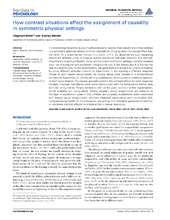| dc.description.abstract | In determining the prime cause of a physical event, people often weight one of two entities in a symmetric physical relation as more important for bringing about the causal effect than the other. In a broad survey (Bender and Beller, 2011), we documented such weighting effects for different kinds of physical events and found that their direction and strength depended on a variety of factors. Here, we focus on one of those: adding a contrast situation that—while being formally irrelevant—foregrounds one of the factors and thus frames the task in a specific way. In two experiments, we generalize and validate our previous findings by using different stimulus material (in Experiment 1), by applying a different response format to elicit causal assignments, an analogue rating scale instead of a forced-choice decision (in Experiment 2), and by eliciting explanations for the physical events in question (in both experiments). The results generally confirm the contrast effects for both response formats; however, the effects were more pronounced with the force-choice format than with the rating format. People tended to refer to the given contrast in their explanations, which validates our manipulation. Finally, people’s causal assignments are reflected in the type of explanation given in that contrast and property explanations were associated with biased causal assignments, whereas relational explanations were associated with unbiased assignments. In the discussion, we pick up the normative questions of whether or not these contrast effects constitute a bias in causal reasoning. | en_US |

